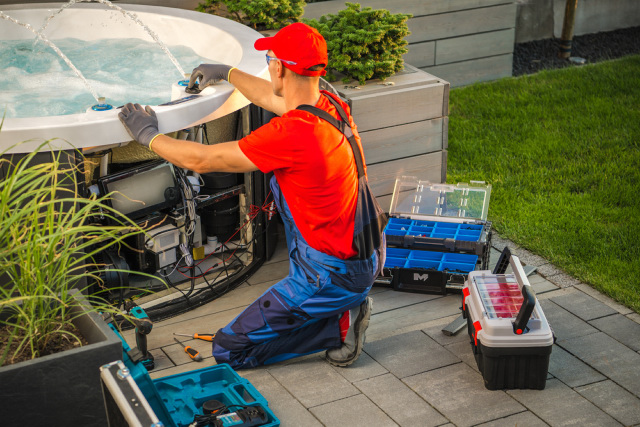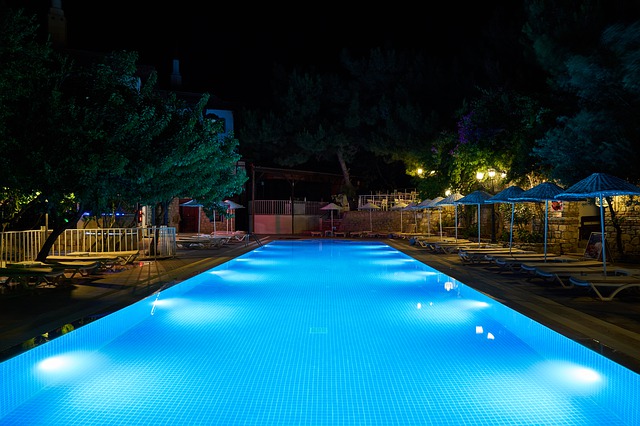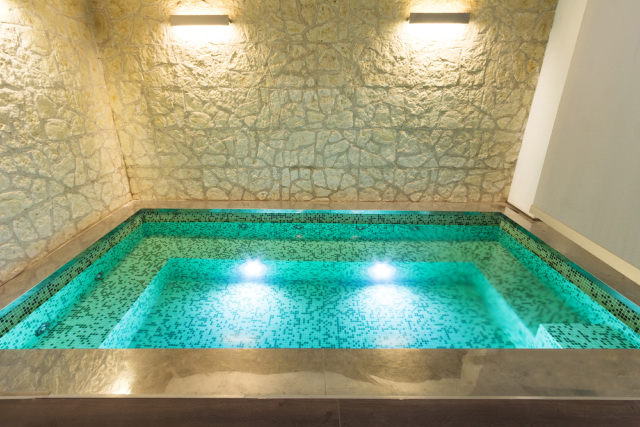Whether you’ve just started your research or are in the middle of installing a swimming pool or hot tub in New York state, you’ll likely know that there are laws, codes, regulations, and requirements that must be met, for the electrical systems.
In this article, we’ll review and try to simplify the current electrical requirements for the state of New York. NYS uses the 2010 Residential Code of NY and the 2020 National Electrical Code (NEC), or NFPA 70. Both of these codes set the standards and requirements that must be met for the safe installation of electrical wiring and equipment.
Keep in mind the information in this article is of general nature only. It does not take into consideration, your location, or personal circumstances. You should seek professional advice from a pool builder and/or qualified electrician before acting on this.

Article Contents
Does My Pool or Hot Tub Need to Comply?
It’s important to note that the codes can be different depending on the type of pool. We’re referring to residential swimming pools. And in addition to this, the rules may vary depending on the type of pool. Different kinds of pools include:
- Permanent Outdoor Pools
- Permanent Indoor Pools
- Permanent Above Ground Pools
- Hot tubs and Spas
- Portable and Inflatable Pools
- Portable hot tubs and spas
Pool definition, as per Article 680.2, The National Electrical Code defines a pool as: “constructed in the ground, or partially in the ground” and “capable of holding water in a depth greater than 1.0 m (42 in.).
And the 2010 Residential Code of NY defines a pool as:
“Any structure, basin, chamber or tank which is intended for swimming, diving, recreational bathing or wading and which contains, is designed to contain, or is capable of containing water more than 24 inches (610 mm) deep at any point. This includes in-ground, above-ground, and on-ground pools; indoor pools; hot tubs; spas; and fixed-in-place wading pools.”
What Does that Mean?
It is implied that your pool needs to comply with these standards if it is 24″ (610 mm) or greater in depth. This goes for indoor pools, above-ground pools, inground pools, portable pools, and inflatable pools.
Do Portable and Inflatable Above Ground Pools Need to Comply?
Portable and inflatable above-ground pools must comply with the electrical standards set out in the 2010 Residential Code of New York if they are 24″ (610 mm) or greater in depth.
Wiring Requirements
There are multiple swimming pools and hot tub wiring requirements in New York state that must be followed.
As per Section E4101 of the 2010 Residential Code of NY, these standards apply to all swimming pools, wading pools, hot tubs, and spas, regardless of if they are portable, or permanently installed.
Here’s a summary of some requirements.
Underground Wires
The standard requirements for swimming pool wiring that is buried or underground can be found in Section E4103.7.
Here’s a summary of the requirements:
- No underground wiring should be installed under a pool
- Underground wiring must be at least 5 feet (1,524 mm) from the inside of a pool wall. PVC conduit needs to be buried deeper than 18″ (12″ if GFCI protected)
Wiring Depths
| Type of Wiring | Minimum Wiring Depth |
| Rigid or Intermediate Metal Conduit | 6″ |
| Nonmetallic raceways without concrete encasement | 18″ |
Exception: The exception to these rules is if the wiring is to supply pool, spa, or hot tub equipment and there is inadequate space to run the cables. In this case, underground wiring needs to be installed in a raceway system constructed of:
- Rigid metal corrosion-resistant conduit
- Intermediate corrosion-resistant metal conduit
- Nonmetallic raceway system
A raceway system is simply an enclosed conduit as listed above.
Overhead Wires
In some cases, you may need overhead wiring. Check out section E4103.6 Overhead Conductor Clearances of the 2010 Residential Code of NY for full details. Here’s a summary of the key points in relation to residential swimming pools:
- Overhead wires need to be at least 10 feet (3,048 mm) away from the inside of a pool or spa wall unless they meet the height requirements.
- Power cables need to be 22.5 feet (6,858 mm) or higher if running above pools, spas, or the edge of diving platforms.
- Communications and coaxial cables should be at least 10 feet (3,048 mm) above a pool, spa, or hot tub.
In other words, unless overhead cables are 10 feet (3,048 mm) away from the edge of the pool, they must be at least 22.5 feet (6,858 mm) above the water.
Related Reading: Do Hot Tubs Need a GFCI? Rules and Codes for Hot Tubs and Swim Spas
Pool Bonding
We won’t go into depth here but pools must be bonded using at least an 8 AWG size solid copper wire.
The treatment is different depending on if your pool is classified as conductive or non-conductive type.
Electrical Outlet Receptacles Requirements
You’ll find the information relating to where you can position the pool pump and pool equipment power outlets (receptacles) in Section E4103.1.X
Here’s a summary:
- Pump and equipment receptacles must be wired with a grounded #12 AWG or larger cable.
- Receptacles for pool pumps must be GFCI protected when located between 6 and 10 feet (1,829 mm and 3,048 mm) from the inside of the pool or spa wall and shouldn’t be located more than 6 feet, 6 inches (1,981 mm) above the floor.
- The receptacles must be locked (twist lock).
- Pump receptacles should not be located within 6 feet (1829 mm) of the pool or spa wall.
- GFCI protection can be a direct connection or by the receptacle.
- Pool pump cords should be double insulated and not exceed 3 feet (914 mm) in length unless they are for a storable pool, hot tub, or for underwater lighting.
Do Pool Pumps Require Their Own Circuit?
Pool pumps must be on their own circuit and go directly to the distribution board (panel box). They must also use #12 AWG or thicker grounded copper wire.
Related Reading: How to Fix Pool Pump Tripping Circuit Breaker (Repeatedly)
When Do You Need a GFCI?
Pool pumps and other water pump motors located between 6 and 20 feet of the pool must use a ground fault circuit interrupter (GFCI) to protect them. Either the receptacle needs to be protected or it can be a direct connection to GFCI.
Other power outlets (receptacles), within 20 feet (6,096 mm) from the inside of the pool’s wall, must have GFCI.
Pool and Hot Tub Lighting Codes
Outdoor Pools & Hot Tubs
There are a few key regulations for lighting for outdoor pools and hot tubs in NYS. For outdoor pools, Section E4103.4.1 of the 2010 Residential Cost of NY states:
- No lights or lighting outlets are to be suspended over a pool unless they are more than 12 feet (3,658 mm) above the maximum water level.
- No lights or lighting outlets should be within 5 feet (1,524 mm) (horizontally) from the inside walls of a pool unless they are 12 feet (3,658 mm) above the water.

Indoor Pools & Hot Tubs
The lighting requirements for indoor pools, hot tubs, and spas in New York state are a little different from the rules for outdoor.
- Lights (luminaries) and lighting outlets within 5 feet (1,524 mm) from the edge of a pool or above a pool need to be at least 7 feet 6 inches (2,286 mm) above the water level. They must also have GFCI protection.
- If they are a minimum of 12 feet (3,658 mm) above the maximum water level, they do not require GFCI protection. This includes ceiling fans.
Exceptions: Lighting may be installed lower than 7 feet 6 inches (2,286 mm) from the pool water level if they are suitable for damp locations. They must also have a glass or plastic lenses and be nonmetallic or have electrically isolated metal trim.

Can You Install Lights Above Swimming Pools or Hot Tubs?
For outdoor pools and hot tubs, no lights, fans, or lighting outlets are allowed to be suspended over the water unless they are more than 12 feet (3,658 mm) above the maximum water level or more than 5 feet (1,524 mm) from the edge of the pool or spa.
For indoor pools, lights, lighting outlets, and fans must be at least 7 feet 6 inches (2,286 mm) higher than the water level and be protected by a GFCI unless they are lights suitable for damp locations. This includes lights within 5 feet (1,524 mm) from the edge of the pool or spa.
Related Reading: Pool Lighting – Complete Guide: Planning to Installing
Conclusion
I hope this has given you some insights into the electrical requirements for swimming pools and hot tubs located in the state of New York. There are many more requirements and nuances than we have listed here but we hope this gives you a starting point.
Check with a licensed electrician before you act on any of this information.
Related Reading: Do Pool Pumps Require GFCI Breaker Protection? Rules, codes and laws for Above Ground Pools.

